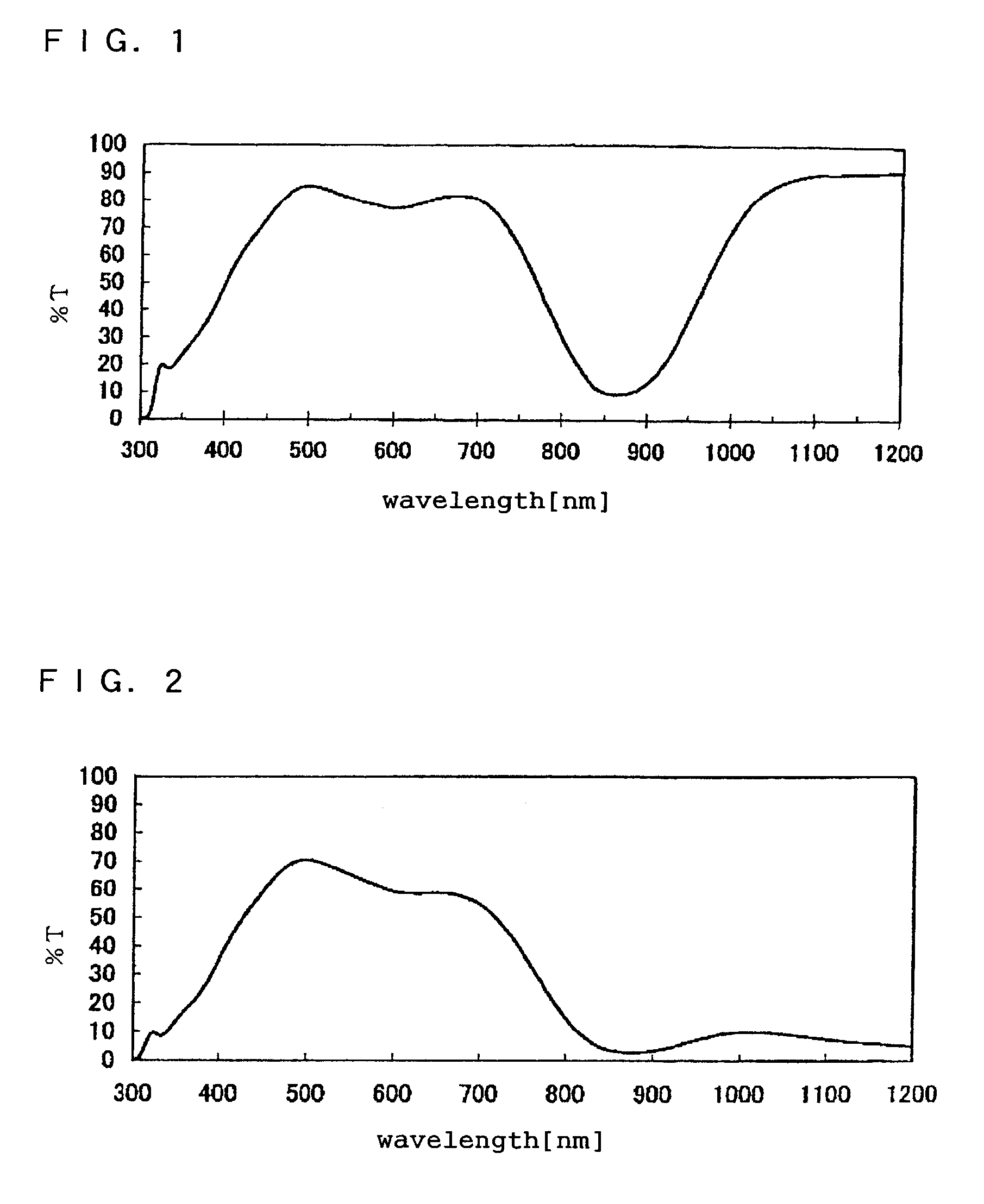Near infrared ray shielding film
a screening film and infrared shielding technology, applied in the direction of spectral modifiers, synthetic resin layered products, textiles and paper, etc., can solve the problems of reducing the handling properties reducing the handling properties in processing or assembly steps, and reducing the bonding force of pressure sensitive adhesive layers. , to achieve the effect of preventing the malfunction of peripheral equipment, excellent handling properties, and high visible light transmission
- Summary
- Abstract
- Description
- Claims
- Application Information
AI Technical Summary
Benefits of technology
Problems solved by technology
Method used
Image
Examples
example 1
[0202]Molten polyethylene terephthalate (PET, [η]=0.65) containing 0.05 wt % of the EX814K near infrared light absorber of Nippon Shokubai Co., Ltd., 0.05 wt % of the EX812K near infrared light absorber of Nippon Shokubai Co., Ltd. and 0.007 wt % of porous silica having an average particle diameter of 1.7 μm was extruded from a die and cooled on a cooling drum by a commonly used method to obtain an unstretched film. This unstretched film was stretched to 3.5 times in a longitudinal direction at 90° C. Thereafter, an aqueous solution containing 8% of the following coating composition was uniformly applied to both sides of the stretched film with a roll coater, and then the resulting laminate was stretched to 3.8 times in a transverse direction at 120° C. while it was dried at 95° C. and heat set at 230° C. to obtain a near infrared screening film having a thickness of 188 μm. The thickness of the adhesive layer was 0.15 μm. The evaluation results of the obtained film are shown in Tab...
examples 2 and 3
[0204]The procedure of Example 1 was repeated except that the near infrared light absorber was changed as shown in Table 1. The evaluation results of the obtained films are shown in Table 1. The transmittance of the film used in Example 2 is shown in FIG. 1.
example 4
[0205]Molten polyethylene-2,6-naphthalene dicarboxylate (PEN, [η]=0.65) containing 0.05 wt % of the EX814K near infrared light absorber of Nippon Shokubai Co., Ltd., 0.05 wt % of the EX812K near infrared light absorber of Nippon Shokubai Co., Ltd. and 0.007 wt % of porous silica having an average particle diameter of 1.7 μm was extruded from a die and cooled on a cooling drum by a commonly used method to obtain an unstretched film. This unstretched film was stretched to 3.5 times in a longitudinal direction at 130° C. Thereafter, an aqueous solution containing 8% of the following coating composition was uniformly applied to both sides of the stretched film with a roll coater, and then the resulting laminate was stretched to 3.8 times in a transverse direction at 120° C. while it was dried at 145° C. and heat set at 230° C. to obtain a near infrared screening film having a thickness of 188 μm. The thickness of the adhesive coating film was 0.15 μm. The evaluation results of the obtai...
PUM
| Property | Measurement | Unit |
|---|---|---|
| transmittance | aaaaa | aaaaa |
| transmittance | aaaaa | aaaaa |
| temperature | aaaaa | aaaaa |
Abstract
Description
Claims
Application Information
 Login to View More
Login to View More - R&D
- Intellectual Property
- Life Sciences
- Materials
- Tech Scout
- Unparalleled Data Quality
- Higher Quality Content
- 60% Fewer Hallucinations
Browse by: Latest US Patents, China's latest patents, Technical Efficacy Thesaurus, Application Domain, Technology Topic, Popular Technical Reports.
© 2025 PatSnap. All rights reserved.Legal|Privacy policy|Modern Slavery Act Transparency Statement|Sitemap|About US| Contact US: help@patsnap.com



